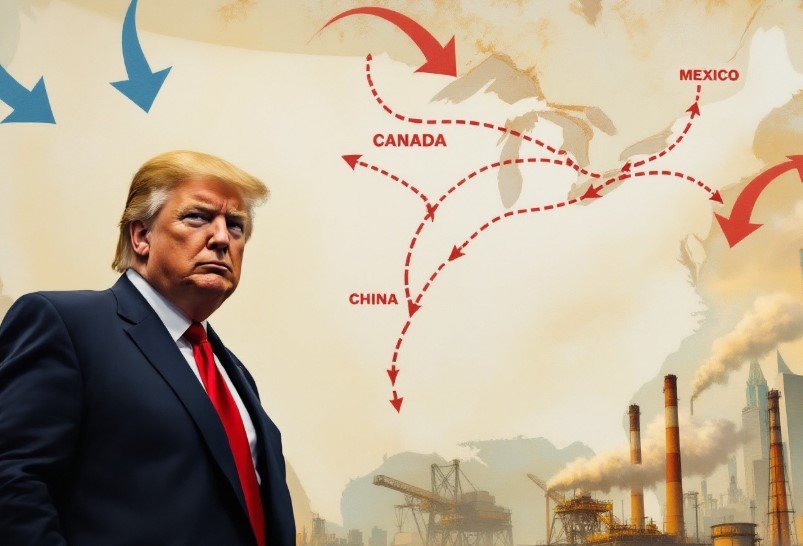Won tumbles, stocks spiral, and nerves fray as Seoul scrambles for answers
Markets in South Korea opened the week with a thud. A late-night announcement from U.S. President Donald Trump slapped a 25% tariff on all South Korean imports, catching policymakers and investors completely off guard. The ripple was instant — the won dipped, stocks sold off, and investors around Asia looked rattled.
And this isn’t just about Seoul. The tariff shock reverberated far beyond the peninsula, cracking confidence in other emerging markets that had been holding their breath over trade noise from Washington.
Trump Goes Full Tariff on Seoul — With a Warning
Trump didn’t hold back. In an unusually direct letter to South Korean President Lee Jae-myung, he laid out what he called a “corrective measure” against “decades of unfair trade.”
One sentence stood out: “If for any reason you decide to raise your tariffs, then, whatever the number you choose to raise them by, will be added onto the 25% that we charge.”
It sounded more like a threat than a negotiation. And the markets heard it loud and clear.
The announcement came late Sunday night, Washington time. By Monday morning in Seoul, traders had already started dumping the won. Stocks tied to export-heavy sectors — electronics, shipbuilding, steel — led the bloodbath.

South Korean Won Takes a Beating
Within the first 30 minutes of trading on July 7, the South Korean won dropped 1.1% to 1,378 against the U.S. dollar. That might sound like a modest slide. But in currency markets, that’s steep.
Just one week ago, the won had shown signs of recovery after a tough June. Now, it’s back to May levels.
The iShares MSCI South Korea ETF (EWY), a bellwether for foreign investor sentiment, logged its sharpest single-day loss since April. Tech names like Samsung Electronics and SK Hynix were battered.
One trader in Seoul’s financial district put it bluntly: “We were blindsided.”
Here’s how Monday’s key South Korean financial indicators performed:
| Indicator | Monday Close | % Change |
|---|---|---|
| KOSPI Index | 2,614.74 | -2.3% |
| South Korean Won (KRW/USD) | 1,378.10 | -1.1% |
| EWY ETF (U.S. Market) | $62.35 | -3.4% |
| Samsung Electronics | ₩68,900 | -2.6% |
| SK Hynix | ₩124,500 | -3.8% |
Seoul Caught Off Guard, Scrambling for Response
President Lee’s office confirmed they received Trump’s letter but did not issue an immediate formal response. An emergency trade committee meeting was convened by noon in Seoul.
In private, government officials said they were “shocked” by the sudden escalation.
One person familiar with the talks said they were “reviewing all options” — including filing a complaint with the World Trade Organization or implementing tit-for-tat tariffs.
But retaliation won’t come easy. South Korea exports over $95 billion worth of goods to the U.S. annually — ranging from cars to semiconductors.
There’s also the uncomfortable fact that South Korea is home to 28,500 U.S. troops and heavily reliant on Washington’s security guarantees.
So what now?
• Officials are working to gauge how deeply this will hurt specific sectors.
• Trade ministry insiders are reportedly consulting with legal teams to explore WTO channels.
• A delegation may fly to Washington before August to seek exemptions or delays.
Emerging Markets Shake as BRICS Warning Adds More Fuel
The sell-off wasn’t isolated to Seoul. Markets in Taiwan, Thailand, and Indonesia all felt the heat. Currencies slipped across the board, as investors braced for a broader trade war redux.
But the real sting came from another Trump remark: his warning of a 10% tariff on all BRICS-aligned countries if they don’t “negotiate by August 1.”
That’s a whole new ballgame.
Brazil, India, China, and South Africa — all key BRICS members — now face the same uncertainty. Trump did not clarify which policies he deemed “Anti-American,” but the threat alone was enough to darken sentiment globally.
Two traders in Singapore said they were preparing for “full-blown portfolio rebalancing” this week.
U.S. Firms Could Get a Boost — But at a Cost
Trump added a strange olive branch: no tariffs would apply if South Korean companies moved production to the U.S.
He promised “expedited approvals” for any South Korean firm willing to set up shop stateside, saying permits would be issued “in a matter of weeks.”
This kind of proposal could potentially lure some firms, especially in sectors like electric vehicle components, where proximity to U.S. automakers matters.
But make no mistake — relocation is costly.
And South Korean executives aren’t exactly rushing to pack up and leave. One industry source called the offer “political bait, not policy.”
What’s Next? Investors Eye July 15 Meeting
All eyes are now on the July 15 meeting scheduled between U.S. Trade Representative Katherine Tai and her South Korean counterpart.
Markets are clinging to hope that some kind of off-ramp may emerge.
Meanwhile, analysts at Nomura, HSBC, and Goldman Sachs have already downgraded South Korean GDP forecasts for the third quarter, citing trade disruption and investor pullback.
In Seoul, the mood is bleak. And with Trump doubling down, the tariff clock is ticking.
